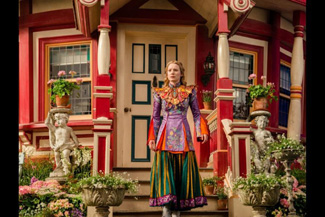Movie Review: Alice Through the Looking Glass
By Ben Gruchow
June 7, 2016
Readers and fans of Lewis Carroll’s novel Through the Looking-Glass may now safely and assuredly find the exits; this film resembles its source material only in the sense that it contains a similar title and characters with the same names. There is a momentary feint toward capturing the source material’s references to chess in the scene between Alice and Absolem - the setting is a kind of purgatory between Underland and the “real” world - and there is of course the White Queen and the Red Queen. Of the White and Red Kings there are no trace; instead, much of what we see with the Queens takes the form of a backstory designed to identify where they fractured as sisters, and how the Red Queen attained such a hydrocephalic head. The explanations for these are fitting in an absurd fashion that fits a fairy tale or fable, but influenced by Carroll’s book they are not.
This, more than anything else, is what I attribute the movie’s rather toxic reception; the wild variance in storytelling, the change in director, and the six-year gap between release dates lends this film the feel of a cash-in done on the cheap, rather than a direct sequel done with most of the same returning crew and with a production budget as lush and extravagant as the first project (one of the movie’s few undisputed triumphs is once again Colleen Atwood’s exquisite costume design, loudly reminiscent of various time periods and trends without being identifiably stapled to any of them in particular).
Certainly much attention was lavished on sets and visual effects; I’m starved for memory of anything that happens in the third act of Alice in Wonderland other than the fact that it involves a big dragon, but this film’s visualization of time’s effect on the world - manifested as everything from ground to water to inhabitants freezing and calcifying under a cracked and rusted copper/bronze crust - has not yet faded from my memory, and it’s one of the few aspects of the film that truly sparks with some kind of grandeur.
There are other little moments that I liked, particularly the character’s free-wheeling willingness to apply puns as their first instinct when dealing with Time; the character resolution at film’s end generally plays fair and honest, and I liked the way that the movie applied various motivations and regrets about the degenerative effect that time can have across the three main stories it has to tell - the Hatter and his family (here is where I suspect former director Tim Burton had some influence; it plays off of some of the same father-son themes he likes to explore in his own work); the Red and White Queen’s acrimony over a childhood incident, and Alice’s own unresolved question of carrying on her father’s legacy. The movie invests in these with about the same level of energy I used to type them out, though, and by the end there’s precious little for our grasp to close on besides a handful of vivid and exciting images and movements. The ingredients were here for a good film, poignant and exciting, but they never finished baking.
Continued:
1
2




